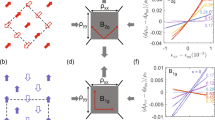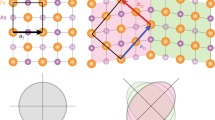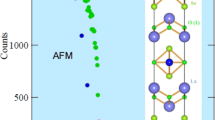Abstract
Nematic fluctuations and order play a prominent role in material classes such as the cuprates1, some ruthenates2 or the iron-based compounds3,4,5,6 and may be interrelated with superconductivity7,8,9,10,11. In iron-based compounds12 signatures of nematicity have been observed in a variety of experiments. However, the fundamental question as to the relevance of the related spin13, charge9,14 or orbital8,15,16 fluctuations remains open. Here, we use inelastic light (Raman) scattering and study Ba(Fe1−xCox)2As2 (0 ≤ x ≤ 0.085) for getting direct access to nematicity and the underlying critical fluctuations with finite characteristic wavelengths17,18,19,20,21. We show that the response from fluctuations appears only in B1g (x2 − y2) symmetry (1 Fe unit cell). The scattering amplitude increases towards the structural transition at Ts but vanishes only below the magnetic ordering transition at TSDW < Ts, suggesting a magnetic origin of the fluctuations. The theoretical analysis explains the selection rules and the temperature dependence of the fluctuation response. These results make magnetism the favourite candidate for driving the series of transitions.
This is a preview of subscription content, access via your institution
Access options
Subscribe to this journal
Receive 12 print issues and online access
$259.00 per year
only $21.58 per issue
Buy this article
- Purchase on SpringerLink
- Instant access to full article PDF
Prices may be subject to local taxes which are calculated during checkout





Similar content being viewed by others
References
Ando, Y., Segawa, K., Komiya, S. & Lavrov, A. N. Electrical resistivity anisotropy from self-organized one dimensionality in high-temperature superconductors. Phys. Rev. Lett. 88, 137005 (2002).
Borzi, R. A. et al. Formation of a nematic fluid at high fields in Sr3Ru2O7 . Science 315, 214–217 (2007).
Chu, J.-H. et al. In-plane resistivity anisotropy in an underdoped iron arsenide superconductor. Science 329, 824–826 (2010).
Chu, J.-H., Kuo, H.-H., Analytis, J. G. & Fisher, I. R. Divergent nematic susceptibility in an iron arsenide superconductor. Science 337, 710–712 (2012).
Fernandes, R. M., Chubukov, A. V. & Schmalian, J. What drives nematic order in iron-based superconductors? Nature Phys. 10, 97–104 (2014).
Kuo, H.-H., Chu, J.-H., Kivelson, S. A. & Fisher, I. R. Ubiquitous signatures of nematic quantum criticality in optimally doped Fe-based superconductors. Preprint at http://arXiv.org/abs/1503.00402 (2015).
Lederer, S., Schattner, Y., Berg, E. & Kivelson, S. A. Enhancement of superconductivity near a nematic quantum critical point. Phys. Rev. Lett. 114, 097001 (2015).
Baek, S.-H. et al. Orbital-driven nematicity in FeSe. Nature Mater. 14, 210–214 (2014).
Thorsmølle, V. K. et al. Critical charge fluctuations in iron pnictide superconductors. Phys. Rev. Lett. Preprint at http://arXiv.org/abs/1410.6456 (2014).
Gallais, Y., Paul, I., Chauviere, L. & Schmalian, J. Nematic resonance in the Raman response of iron-based superconductors. Preprint at http://arXiv.org/abs/1504.04570 (2015).
Capati, M. et al. Electronic polymers and soft-matter-like broken symmetries in underdoped cuprates. Nature Commun. 6, 7691 (2015).
Kamihara, Y., Watanabe, T., Hirano, M. & Hosono, H. Communication iron-based layered superconductor La[O1−x F x ]FeAs (x = 0.05–0.12) with T c = 26 K. J. Am. Chem. Soc. 130, 3296 (2008).
Fernandes, R. M., Chubukov, A. V., Knolle, J., Eremin, I. & Schmalian, J. Preemptive nematic order, pseudogap, and orbital order in the iron pnictides. Phys. Rev. B 85, 024534 (2012).
Gallais, Y. et al. Observation of incipient charge nematicity in Ba(Fe1−x Co x )2As2 . Phys. Rev. Lett. 111, 267001 (2013).
Kontani, H., Saito, T. & Onari, S. Origin of orthorhombic transition, magnetic transition, and shear-modulus softening in iron pnictide superconductors: analysis based on the orbital fluctuations theory. Phys. Rev. B 84, 024528 (2011).
Kontani, H. & Yamakawa, Y. Linear response theory for shear modulus C 66 and Raman quadrupole susceptibility: evidence for nematic orbital fluctuations in Fe-based superconductors. Phys. Rev. Lett. 113, 047001 (2014).
Caprara, S., Di Castro, C., Grilli, M. & Suppa, D. Charge-fluctuation contribution to the Raman response in superconducting cuprates. Phys. Rev. Lett. 95, 117004 (2005).
Caprara, S. et al. Signatures of nematic quantum critical fluctuations in the Raman spectra of lightly doped cuprates. Phys. Rev. B 91, 205115 (2015).
Khodas, M. & Levchenko, A. Raman scattering as a probe of nematic correlations. Phys. Rev. B 91, 235119 (2015).
Karahasanovic, U. et al. Manifestation of nematic degrees of freedom in the Raman response function of iron pnictides. Phys. Rev. B 92, 075134 (2015).
Yamase, H. & Zeyher, R. Spin nematic fluctuations near a spin-density-wave phase. New J. Phys. 17, 073030 (2015).
Chu, J.-H., Analytis, J. G., Kucharczyk, C. & Fisher, I. R. Determination of the phase diagram of the electron-doped superconductor Ba(Fe1−x Co x )2As2 . Phys. Rev. B 79, 014506 (2009).
Yoshizawa, M. et al. Structural quantum criticality and superconductivity in iron-based superconductor Ba(Fe1−x Co x )2As2 . J. Phys. Soc. Jpn 81, 024604 (2012).
Böhmer, A. E. et al. Nematic susceptibility of hole-doped and electron-doped BaFe2As2 iron-based superconductors from shear modulus measurements. Phys. Rev. Lett. 112, 047001 (2014).
Yi, M. et al. Symmetry-breaking orbital anisotropy observed for detwinned Ba(Fe1−x Co x )2As2 above the spin density wave transition. Proc. Natl Acad. Sci. USA 108, 6878–6883 (2011).
Mirri, C. et al. Hysteretic behavior in the optical response of the underdoped Fe-arsenide Ba(Fe1−x Co x )2As2 in the electronic nematic phase. Phys. Rev. B 89, 060501 (2014).
Lee, W.-C., Zhang, S.-C. & Wu, C. Pairing state with a time-reversal symmetry breaking in FeAs-based superconductors. Phys. Rev. Lett. 102, 217002 (2009).
Choi, K.-Y. et al. Self-energy effects and electron–phonon coupling in Fe–As superconductors. J. Phys. Condens. Matter 22, 115802 (2010).
Mazin, I. I. et al. Pinpointing gap minima in Ba(Fe0.94Co0.06)2As2 via band-structure calculations and electronic Raman scattering. Phys. Rev. B 82, 180502 (2010).
Muschler, B. et al. Electron interactions and charge ordering in CuO2 compounds. Eur. Phys. J. Spec. Top. 188, 131–152 (2010).
Rotter, M., Tegel, M. & Johrendt, D. Superconductivity at 38 K in the iron arsenide (Ba1−x K x )Fe2As2 . Phys. Rev. Lett. 101, 107006 (2008).
Devereaux, T. P. & Hackl, R. Inelastic light scattering from correlated electrons. Rev. Mod. Phys. 79, 175–233 (2007).
Götze, W. & Wölfle, P. Homogeneous dynamical conductivity of simple metals. Phys. Rev. B 6, 1226–1238 (1972).
Allen, J. W. & Mikkelsen, J. C. Optical properties of CrSb, MnSb, NiSb, and NiAs. Phys. Rev. B 15, 2952–2960 (1977).
Opel, M. et al. Carrier relaxation, pseudogap, and superconducting gap in high-T c cuprates: a Raman scattering study. Phys. Rev. B 61, 9752–9774 (2000).
Acknowledgements
We acknowledge useful discussions with T. P. Devereaux, Y. Gallais, S. A. Kivelson, B. Moritz and I. Paul. Financial support for the work came from the German Research Foundation DFG through the Priority Program SPP 1458 (project nos HA 2071/7 and SCHM 1035/5), from the Bavarian Californian Technology Center BaCaTeC (project no. A5 [2012-2]), and from the Transregional Collaborative Research Center TRR 80. U.K. and J.S. were supported by the Helmholtz Association, through the Helmholtz postdoctoral grant PD-075 ‘Unconventional order and superconductivity in pnictides’. R.H. thanks the Stanford Institute for Materials and Energy Sciences (SIMES) at Stanford University and SLAC National Accelerator Laboratory for hospitality. Work in the SIMES at Stanford University and SLAC was supported by the US Department of Energy, Office of Basic Energy Sciences, Division of Materials Sciences and Engineering, under Contract No. DE-AC02-76SF00515.
Author information
Authors and Affiliations
Contributions
F.K., T.B., B.M., A.B. and D.J. contributed approximately equally to the experiments. U.K., J.S., S.C., M.G. and C.D.C. developed the theory. J.-H.C., J.G.A. and I.R.F. prepared and characterized the samples. F.K., T.B. and R.H. conceived the study. U.K., F.K., T.B. and R.H. prepared the manuscript.
Corresponding author
Ethics declarations
Competing interests
The authors declare no competing financial interests.
Supplementary information
Supplementary information
Supplementary information (PDF 2478 kb)
Rights and permissions
About this article
Cite this article
Kretzschmar, F., Böhm, T., Karahasanović, U. et al. Critical spin fluctuations and the origin of nematic order in Ba(Fe1−xCox)2As2. Nature Phys 12, 560–563 (2016). https://doi.org/10.1038/nphys3634
Received:
Accepted:
Published:
Issue date:
DOI: https://doi.org/10.1038/nphys3634
This article is cited by
-
An electronic nematic liquid in BaNi2As2
Nature Communications (2022)
-
Quantum critical fluctuations in an Fe-based superconductor
Communications Physics (2022)
-
Lattice-shifted nematic quantum critical point in FeSe1−xSx
npj Quantum Materials (2021)
-
Nematic fluctuations in iron-oxychalcogenide Mott insulators
npj Quantum Materials (2021)
-
Strange semimetal dynamics in SrIrO3
Nature Communications (2020)



